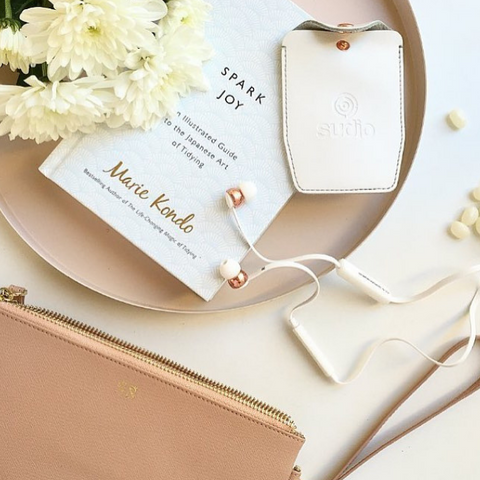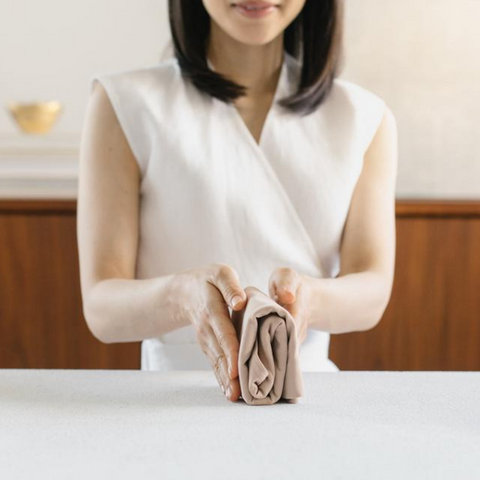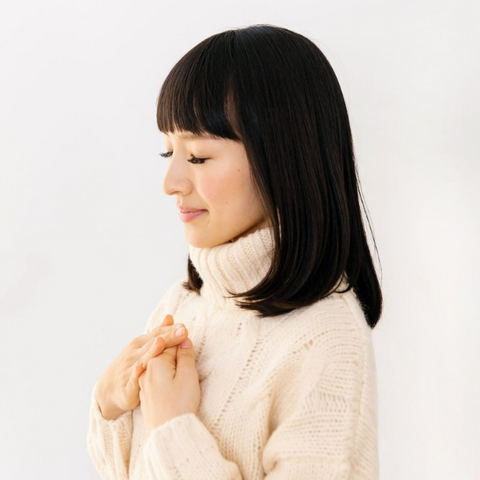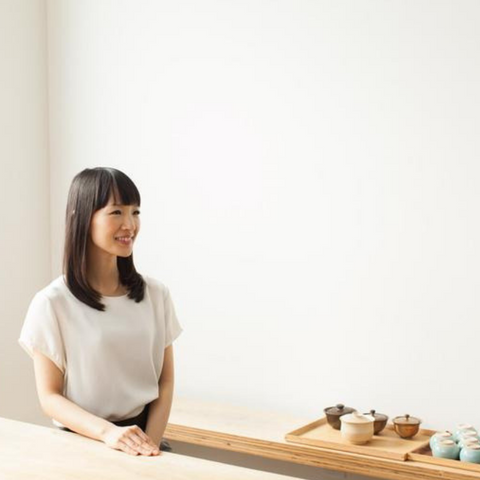Unless you’ve been living under a rock for the past few months, you’ve no doubt heard of Marie Kondo and are wondering how on earth a tidying guru has suddenly taken the world by storm! Kondo has written a few books on tidying, the most famous one being The Life-Changing Magic of Tidying Up, but she really shot to stardom with her wildly popular Netflix series, Tidying Up with Marie Kondo. In her show, Kondo helps various families transform their homes and lives by sorting out their clutter using her KonMari method.
For those who just don’t have time to binge watch all 8 episodes of Tidying Up with Marie Kondo (they can admittedly be a little repetitive), here’s a summary of the top pearls of wisdom I received from the series:
ONLY KEEP WHAT SPARKS JOY
The heart of Kondo’s KonMari method is that we should evaluate whether things spark joy for us, and discard those that do not.

Image: @sarahshanahan_lifestyle
Yes, it may sound a little fluffy and airy-fairy, but it’s actually a very liberating approach to tidying - it forces you to assess what speaks to your heart, and gives you permission to let go of what doesn’t. Many of us can’t turn down a bargain, and have a stash of clothes we’ve bought on sale (some with tags still on!) that if we’re honest with ourselves, know we will never wear. You don’t have to feel guilty about getting rid of these – in fact, giving them away means that they might spark joy for someone else, instead of being forgotten in the deepest darkest corners of your wardrobe!
Some items that we hold onto however, are just junk, plain and simple. I can be a little bit of a hoarder, something I inherited from my dad – we both find it extremely difficult to get rid of things even though we’re fully aware that we’ll probably never need or want those items ever again. Old encyclopaedias that we’ll never refer to, worn out clothes that have plenty of holes, rips and other battle scars, and old 3.5 inch floppy discs that can barely hold anything. ”But the encyclopaedias are still in perfect condition!” we’ll protest. “But I can wear those clothes around the house!’ we’ll rationalise. “But those floppy discs might be worth something one day!” we’ll claim defensively. Nope, Marie Kondo will have none of that – since these items definitely don’t spark joy for us, and are unlikely to spark joy for anyone else, in the bin they should go.
The beauty of asking whether your possessions spark joy, is that what you’re left with, are all your most beautiful and treasured things. You’ll end up surrounded by things you love, and every outfit in your wardrobe will be your favourite outfit. For years I’ve been rotating through the same small number of outfits in my haste to get ready and head out – I only saw (and therefore only wore) what was in front of me when I opened up my wardrobe doors. But after sifting out all my non-joy-sparking items, my clothes were no longer crammed into one another and I could see outfits I’d always loved, but that I hadn’t worn in years. How ironic that by getting rid of half my wardrobe, I feel like I’ve actually gained more outfits!

Image - KonMari Media Inc
Not just restricted to tidying, the ‘does it spark joy’ question is being asked by people for all sorts of decisions – who to follow on Instagram, what to eat for dinner, which friendships to cultivate and how to spend our weekends. Once you’ve made the spark joy decision hundreds of times throughout the tidying process, you’ll become more attuned to what brings you joy, and all other decisions will be seen through this lens too.
TIDY UP BY CATEGORY RATHER THAN BY ROOM
Most experts advise that you declutter room by room, but the KonMari method approaches tidying by category instead. The problem with tackling your home by room, is that various items from the not-yet-tidied rooms, will inevitably creep into the completed rooms, and the cycle of mess and clutter will never end. Dealing with one category at a time allows you to actually tick things off your list, particularly if you aren’t able to tidy your whole home in one go (seriously, who has the time?) and need to chip away at it over a few weekends.
Kondo splits everything into 5 categories, and recommends working through them in this exact order:
1. Clothes
2. Books
3. Papers
4. Komono (a ridiculously mammoth category that encompasses all miscellaneous items)
5. Sentimental items
Clothing is the starting point, because for most of us, it’s less emotional, and culling decisions are much easier to make. By the time you’ve worked your way to the immensely difficult sentimental items category, you should be very well versed in what brings you joy.
Using the KonMari method, you begin by pulling out every single item of clothing, regardless of what room it is in, and heaping them into a big pile. You then tackle all your clothing in one go before you even think about tidying anything else. I had always previously tidied by room, and the result was invariably the same; a room that was half-tidied, until I reached any sentimental objects that threw me off track…once I launched into the old photos, letters and certificates, my tidying was officially derailed. This time is different though - now with clothes category behind me, I really feel like I can expertly and confidently move onto the other categories!
FILE UPRIGHT
By far the biggest Kondo revelation I’ve had relates to her folding method and how she seems to store almost everything upright. Instead of crowding all her clothes onto hangers or stacking them in precarious Jenga-esque piles, Kondo uses a folding technique (see video at the bottom of the article) which results in adorable little rectangular parcels that are able to stand upright.

Image - KonMari Media Inc
By lining up these folded packages into a dresser, you not only save a ton of space, but you’re able to see all your clothes at a glance. But the best part? When you’ve spotted what you’re after, you can simply pluck it out of your clothing filing cabinet without disturbing anything else – mind blown!!
To keep everything organised and standing straight, place shoeboxes into your dresser drawers, dividing your tees from your jeans, from your scarves from your socks. Yes, even socks are folded neatly rather than balled up with their elastic edges stretched.

Image - @justanothermummyblog
Ok, I know what you’re thinking – you don’t have time to be neatly folding your clothes into origami rectangles – but trust me, what little extra time this folding technique might take (and I’m not even sure that it does), is definitely saved again and again whenever you get dressed. And as lame as this sounds, I find it oddly therapeutic to fold beautifully and purposely the KonMari way rather than in the sloppy and hasty way I used to do it.
If you don’t have a dresser, not to worry! You can still use the shelves in your wardrobe by getting some storage baskets or boxes and filing your clothes in those instead.

Image - KonMari Media Inc
Kondo stores many other items vertically too, not just clothing, such as tea towels, bedlinen, scarves etc. This ensures that everything is visible, and also prevents things from being crushed and weighed down. It sounds like such a simple and obvious concept to me now as I think of all the things in our home that can be stored upright – I can’t believe we’ve been doing it wrong this whole time!
GRATITUDE SHOULD BE YOUR ATTITUDE
In the Netflix show, Kondo tells the families to thank the items that don’t spark joy before placing them in the toss/donate pile. This sounds fairly cheesy, and my husband and I rolled our eyes in the first episode when she said this, but by the end of the series, I had found a way to interpret this so that it actually resonated with me. It’s not about verbally saying thank you to your clothes (although the families in the show did do this), but about recognising that this item once served a purpose, being grateful for what joy it previously gave you, and letting it go of it without regret.

Image - KonMari Media Inc
So no, I didn’t say thank you to my items (I’m not a crazy lady), but I did feel fortunate to have so many clothes, many more than I need...and by reminding myself that everything has a season, even a hoarder like myself was able to get rid of a lot of things without the usual feelings of guilt.
IT’S NOT A NUMBERS GAME
Something very refreshing about Kondo was that she never made the families feel bad about what they wanted to keep. The focus was not to cull to a certain point or to discard as much as possible, but was instead on making sure that the families were mindful and purposeful about what they wanted to keep. Kondo fully recognises that whether or not something sparks joy is an entirely personal question, and that there is no need to justify the answer to anyone else.
It’s not about having less stuff, but about only being surrounded by the stuff that makes you happy.

Image - KonMari Media Inc
YOUR TURN
There you go, I’ve just saved you about 5 hours of Netflix binging – time that can now be spent sorting through your clothes and folding them into perfect parcels! All the best with your tidying journey and happy KonMari-ing!
Looking for dressers and other storage solutions? Browse our collection of storage furniture and discover some beautiful pieces that spark joy.
Banner image source: KonMari Media Inc
